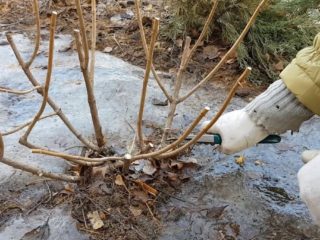Content
- 1 Description of hydrangea paniculata Polar Beer
- 2 Hydrangea Polar Beer in landscape design
- 3 Winter hardiness of hydrangea Polar Bear
- 4 Planting and caring for the Polar Bear hydrangea
- 5 How the hydrangea grows by Polar Beer
- 6 Reproduction
- 7 Diseases and pests
- 8 Conclusion
- 9 Reviews of panicle hydrangea Polar Beer
Hydrangea Polar Bear is highly valued among gardeners, the reasons for this are not only the attractiveness of the plant from a decorative point of view. The species is very easy to care for, making it ideal for gardening.
Description of hydrangea paniculata Polar Beer
The Polar Bear is a cross between the panicle hydrangeas Limelight and Grandiflora. From its progenitors, the Polar Bear took the best properties - large flowers and high frost resistance, strong branches and unpretentious cultivation.
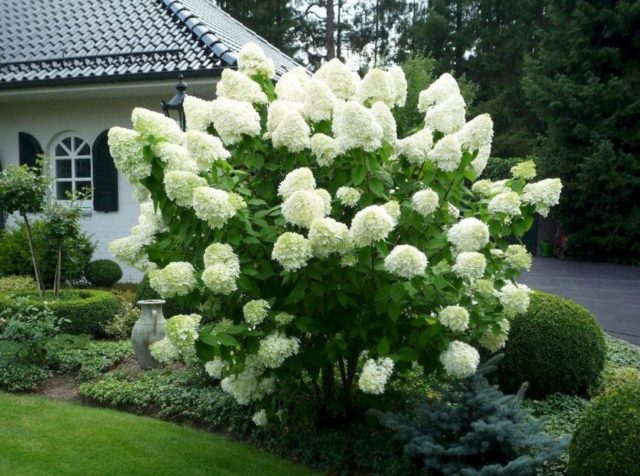
The Polar Bear variety combines endurance and high decorativeness.
Panicle hydrangea is a fairly large plant. The height of the Polar Beer hydrangea is on average 1.8 m in height. The plant blooms in early June and until late autumn in very large pyramidal or paniculate inflorescences, up to 40 cm each. During the flowering period, the hydrangea gradually changes its color - at first its inflorescences are delicate pistachio, then they become white, pinkish or cream.
Hydrangea Polar Beer in landscape design
A beautiful and undemanding hydrangea to care for is very often used to decorate summer cottages. It is used in mixborders and hedges, planted on lawns singly or as part of a group - along with herbaceous perennials and shrubs.
The Polar Bear shrub looks very impressive in almost any composition. Its huge bright inflorescences set off dense greenery or variegated flowers of other plants. An important advantage of the Polar Bear variety is that flowering continues almost until the very frost. Even after the fall of leaves, sprawling flowering bushes still continue to decorate the garden plot.
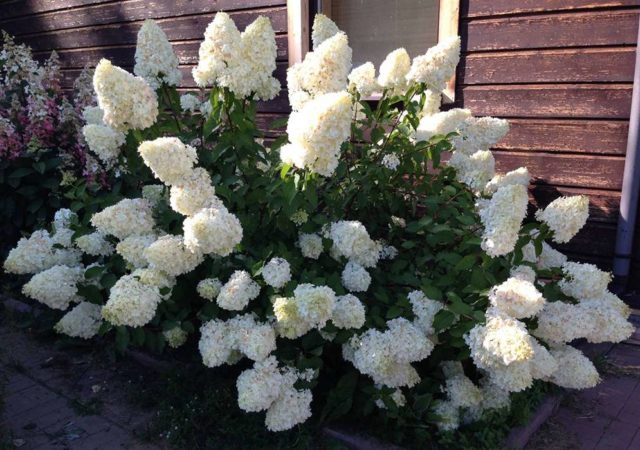
In the landscape of the garden, the variety is used everywhere.
Winter hardiness of hydrangea Polar Bear
Polar Bear is a very cold-resistant variety of decorative hydrangea. This is reflected even in the name of the plant. An ornamental shrub calmly tolerates cold temperatures down to -40 ° C, and it is not even necessary to thoroughly cover it for the winter.
Planting and caring for the Polar Bear hydrangea
It is quite easy to grow a healthy and spreading hydrangea in your country house. But for this, the plant needs to be provided with the right conditions and basic care.
How the hydrangea grows by Polar Beer
As the Polar Bear grows, it stretches not only in height. The size of the Polar Bear hydrangea bush can reach 1.5 m. In addition, the hydrangea has a branched superficial root system, its roots go not so much into the soil as to the sides.
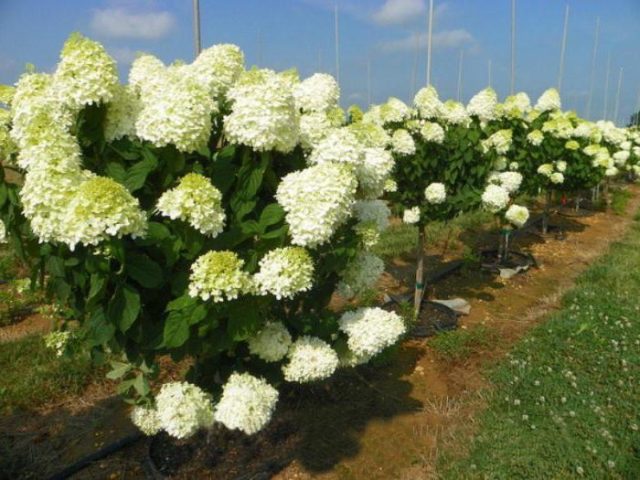
Over time, the bushes grow quite widely, so when planting you need to leave a gap
If the hydrangea needs to be planted near other plants, or it is planned to plant several bushes at once, then it is necessary to leave a free distance between plantings.Gaps of about 1-1.5 m allow the shrub to develop freely and not fight for moisture and nutrients with other plants.
Selection and preparation of the landing site
In order for the Polar Bear panicle hydrangea to grow well, you must initially plant it in the optimal place:
- It is best to plant the plant on the south side of the site, as the hydrangea loves sunlight. However, at the same time, other trees or buildings should be located nearby, they can create a light shade, which is also very important for hydrangea. In the sun, the shrub blooms less abundantly. In addition, in an open place, strong winds can damage it, and buildings and trees can protect the hydrangea.
- The Polar Bear prefers abundant hydration. But swampy soil for hydrangeas is dangerous and can lead to root rot. Therefore, the plant should not be planted in lowlands or in the immediate vicinity of groundwater. If the soil moisture is high, good drainage should be organized.
- The soil for the Polar Bear variety needs fertile - in conditions of a lack of nutrients, the hydrangea will bloom worse. The soil should be neutral or slightly acidic, but not acidic.
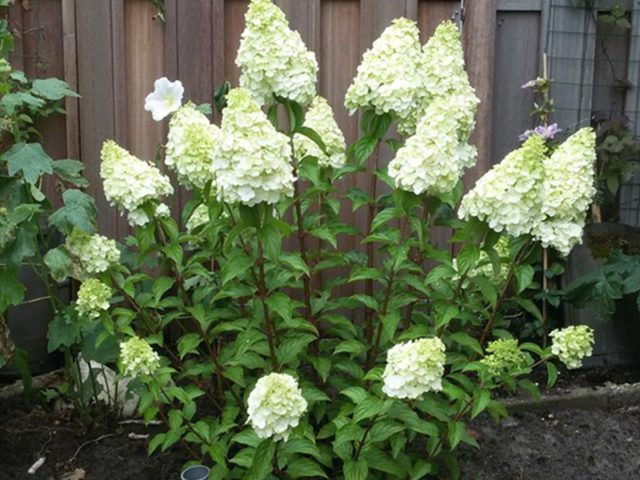
The variety is usually planted in the spring, but in the southern regions this can be done in the fall.
The optimal time to plant a plant is determined by the growing region. Since the Polar Bear has a high frost resistance, in the southern regions it is possible to plant shrubs in the ground in the fall, until mid-October. But in the middle lane and northern regions, it is better to plant in the spring in April, so that the plant has time to take root.
A planting pit for a hydrangea is prepared in advance. The soil in the selected area of the garden is dug up and enriched with additional components, namely:
- mix peat and sand in equal proportions;
- add humus and leafy earth, also in the same quantities, but 2 times more.
When preparing the soil, it is recommended to immediately lay complex mineral fertilizers in the pit, they will help the hydrangea to take root faster.
Landing rules
Since the roots of the hydrangea are of a surface type, they dig a shallow planting hole for it - about 30 cm in depth and the same in diameter. The pit is filled halfway with the prepared nutrient mixture.
After that, the shrub sapling, previously soaked in water, is lowered into the hole and its roots are gently spread along the sides. The pit is covered with the rest of the soil mixture to the surface of the earth, leaving the root collar above the soil level, and the seedling is watered abundantly.
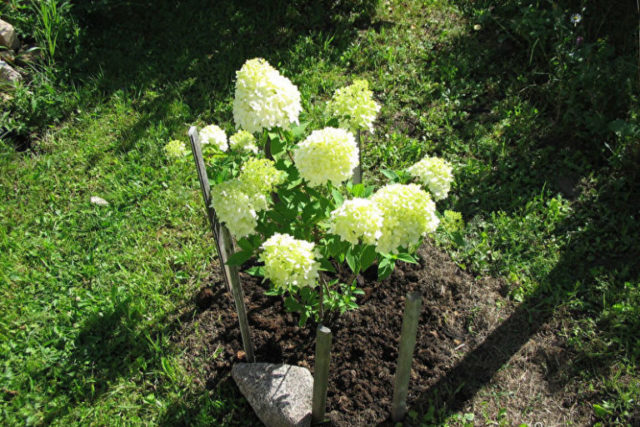
The soil under the trunk of the seedling is not tamped, but loosened
Watering and feeding
Hydrangea Northern Bear loves moisture and blooms more abundantly and brighter with regular moisture. It is recommended to water the hydrangea weekly - a couple of buckets under the trunk, and if the weather is rainy, then once a month.
In order for the moisture from the near-trunk circle to evaporate more slowly, the plant can be mulched with peat, sawdust or humus. It is also useful to loosen the soil in the near-trunk circle from time to time and carry out hilling - in this case, the roots of the bush will receive more oxygen.
For abundant flowering, the plant needs regular feeding. They are usually introduced into the soil several times a year:
- in early spring to build up a green crown;
- in late spring during budding for better flowering;
- in July to strengthen the roots and protect the plant from pests and diseases;
- in the fall before the onset of winter to increase the endurance of the shrub before cold weather.
In the spring, the Polar Bear especially needs fertilizing with a high nitrogen content - ammonium nitrate or urea is a good choice. In summer and autumn, hydrangeas are fed with superphosphate and potassium, and organic matter is also beneficial - manure and humus.
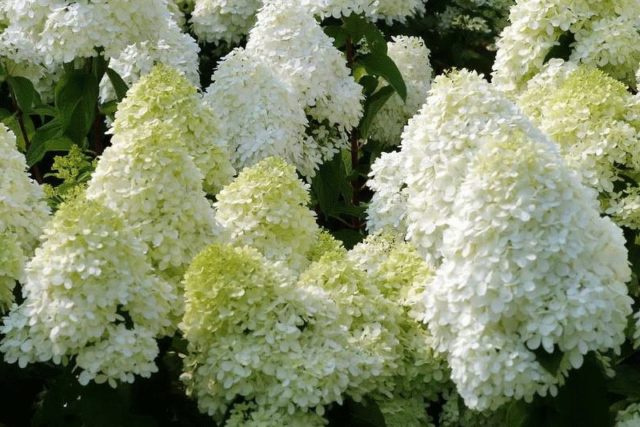
For a beautiful flowering, the shrub needs feeding
How to prune a Polar Bear hydrangea
The panicle hydrangea is prone to rapid growth, therefore, after the fourth year of life, it is recommended to trim it twice a season:
- For the first time, a haircut is carried out in the spring in March, before the start of sap flow. At the Polar Bear, all dry and broken twigs are pruned, which are especially easy to see while the bush is not yet covered with foliage. Also, healthy shoots are cut by 2/3, giving the plant the desired shape.
- The second time the hydrangea is trimmed in the fall. During the autumn haircut, it is also necessary to remove all broken and dried shoots, brown inflorescences and branches that violate the proportions of the bush. Pruning in autumn not only makes the plant healthier, but also protects the hydrangea from breaking off branches under the weight of the snow.
For older Polar Bear hydrangeas, rejuvenating pruning can be done. A mature bush is simply cut off to the very hemp, the next year the plant will give new strong shoots. But it is recommended to resort to a radical procedure only if the old bush began to bloom noticeably weaker.
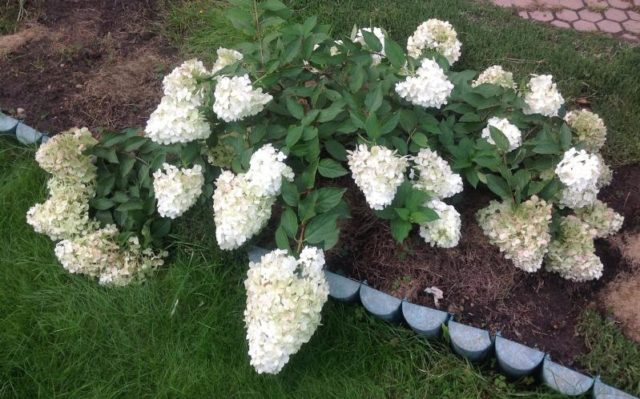
Regular trimming keeps the hydrangea bush beautiful and neat.
Preparing for winter
Polar Bear is remarkable for its amazing frost resistance, up to -40 ° C. And, nevertheless, it is highly recommended to cover the shrub for the winter, especially when it comes to young plants with increased sensitivity.
Shortly before the onset of cold weather, you need to mulch the near-trunk circle of the Polar Bear with sawdust, peat or needles - the layer should be at least 20 cm. Also, young plants are often covered with burlap and covered with spruce branches. The winter shelter protects the shrubs not only from frost, but also from the wind, and also prevents the shoots from breaking under the weight of the snow that has fallen.
Reproduction
Hydrangea Polar Bear lends itself well to vegetative reproduction. If you want to plant more hydrangeas on the site, you do not have to buy new seedlings.
Methods:
- Propagation by cuttings. This method is the easiest and most popular among gardeners. In the spring, several young annual shoots should be cut from an adult hydrangea bush. For 3 days, the cuttings are placed in water, and after that they are planted in the soil of peat and sand, deepening by 2/3. From above, the stalk can be covered with a glass jar or plastic bag. Until green shoots appear, the plant must be kept in moist and cool conditions, and then planted in open ground.
- Reproduction by layering. Another vegetative method is to bend one of the lower healthy shoots to the ground in the spring and fix the branch in the middle in a small groove in the ground. During the summer, the cuttings will only need to be watered at the same time as the adult plant, it will quickly give roots, and the next year it can be separated from the mother bush.
- Reproduction by dividing the rhizome. Old hydrangeas are propagated by division - first, the bush is completely dug out of the ground, and then the rhizome is divided into several parts with a sharpened shovel, each should have a pair of growth buds. Delenki are treated with a solution of potassium permanganate and planted in the ground for rooting.

The variety is propagated vegetatively on the site - trying to grow a shrub from seeds is unprofitable
Seed propagation for the Polar Bear is not practiced. Growing a strong and healthy shrub from seed is too difficult, and long efforts may not be successful.In addition, seedlings usually do not retain varietal characteristics, and in terms of their characteristics and beauty, the plant is significantly inferior to the mother bush.
Diseases and pests
The Polar Bear is considered a disease resistant variety. Of the fungal diseases, chlorosis is the most dangerous for the variety; it develops mainly on poor soils or with excessive watering. The main symptom of the disease is premature yellowing of the foliage of the bush. Hydrangea treatment is carried out with special drugs, for example, Chelate or Antichlorosis.
Of the pests for shrubs, leaf aphids, spider mites, as well as slugs and snails are dangerous. To prevent infection, you need to carefully examine the leaves and shoots of the garden plant. When insects appear, you can treat the shrub with soapy water, Bordeaux liquid or garden insecticides.

The variety is resistant to diseases, but preventive treatment will not harm it
Conclusion
Hydrangea Polar Bear is a hardy and cold-resistant ornamental plant with very large flowers. With minimal maintenance, the Polar Bear will be able to decorate the garden until late autumn.








